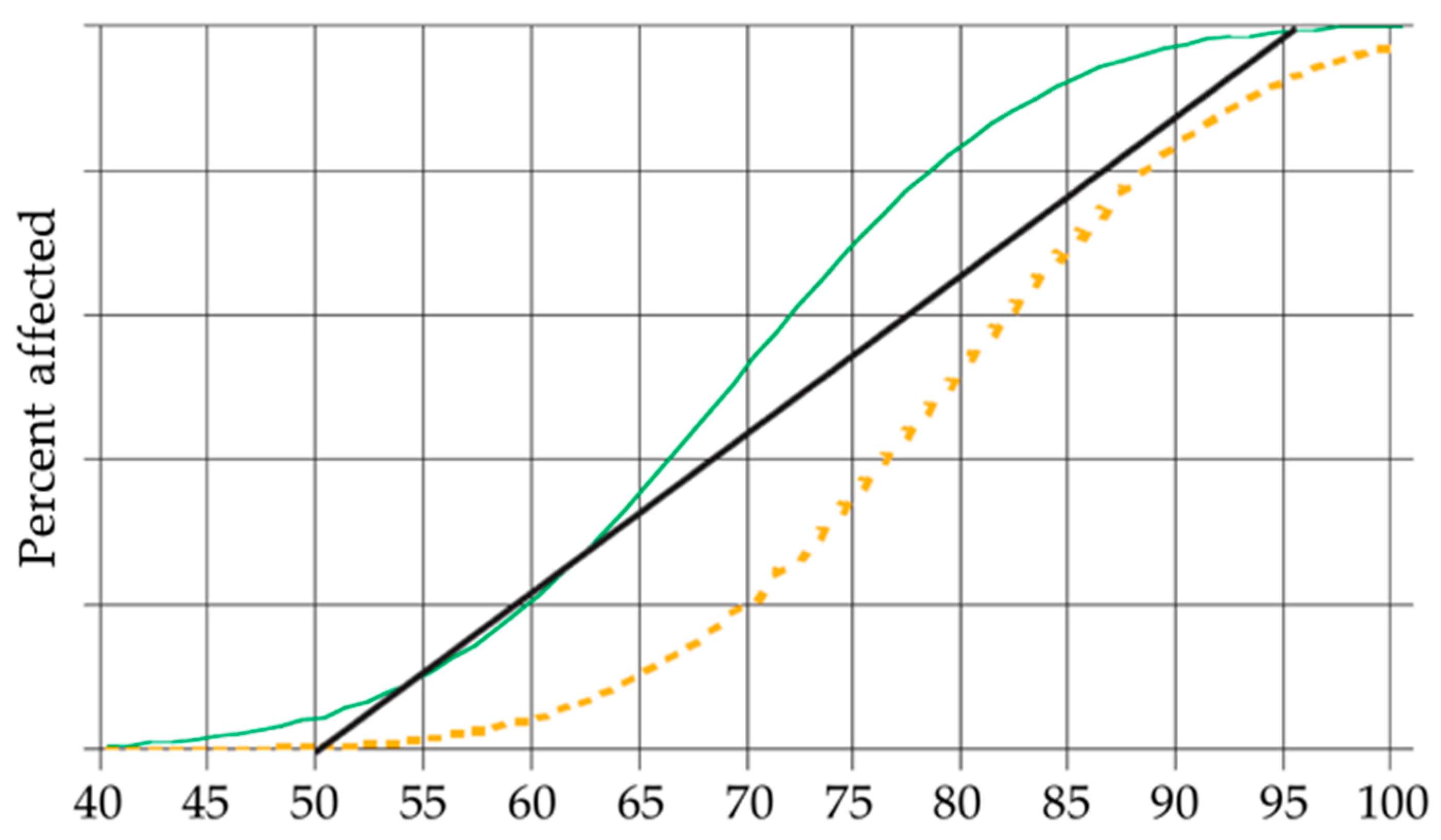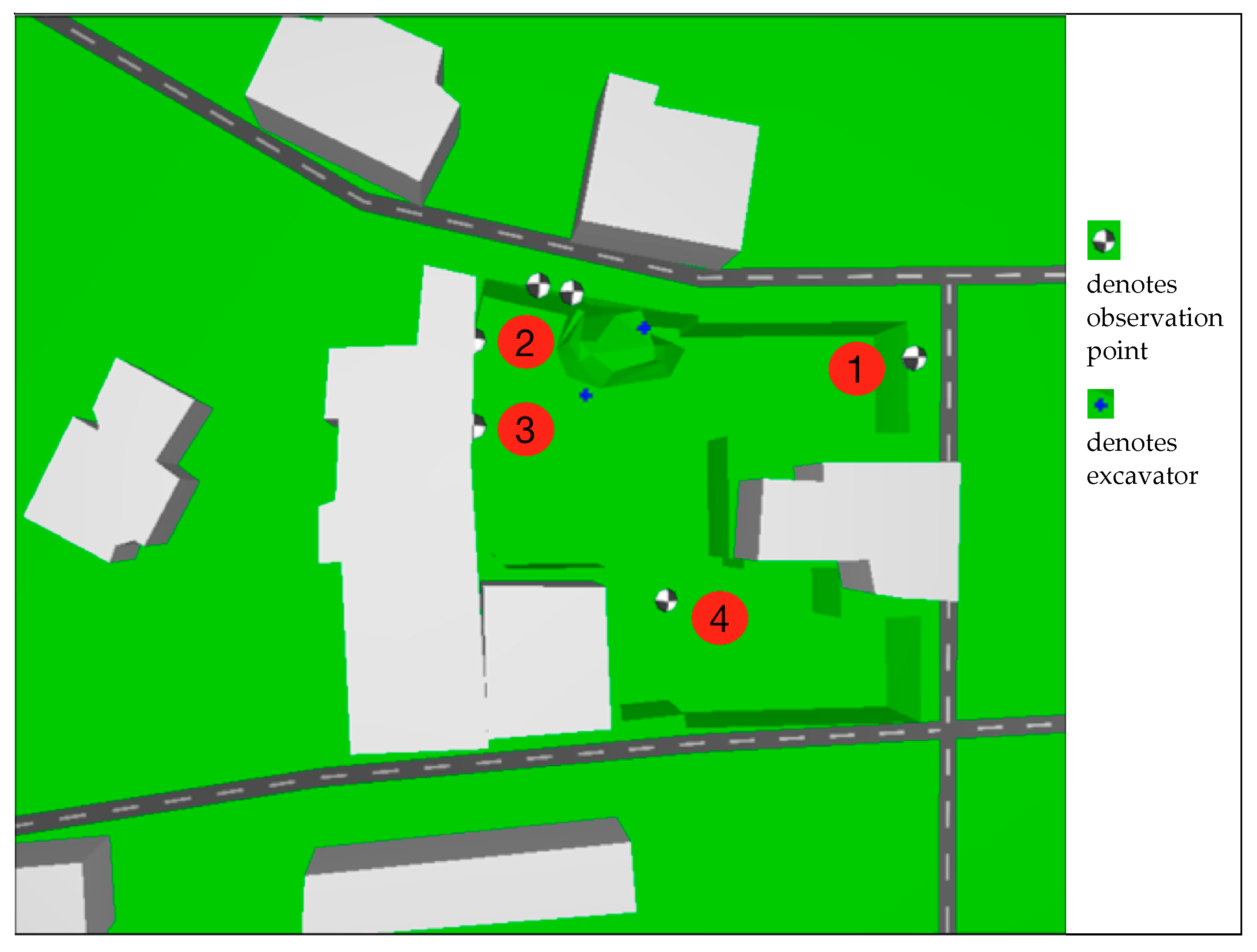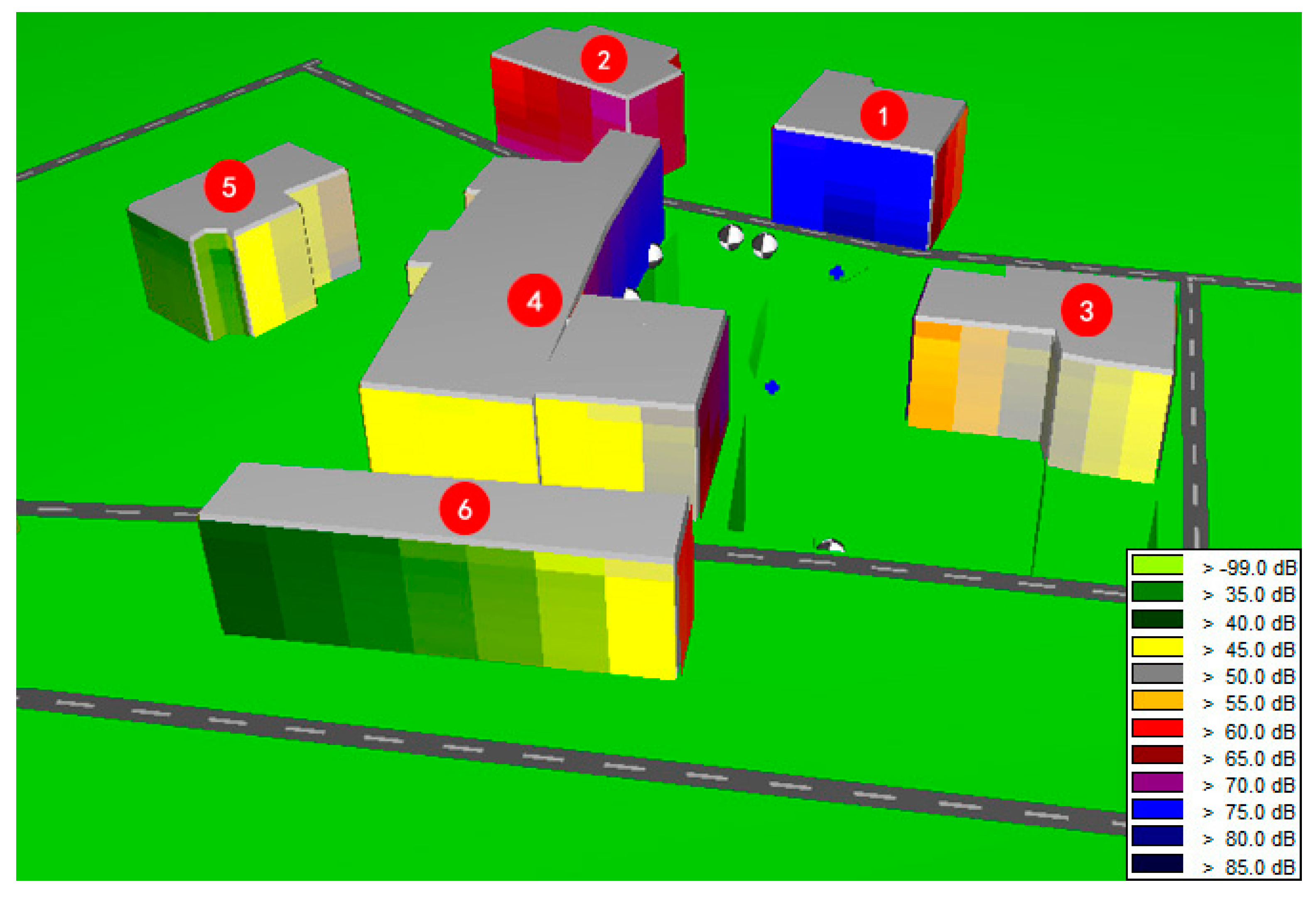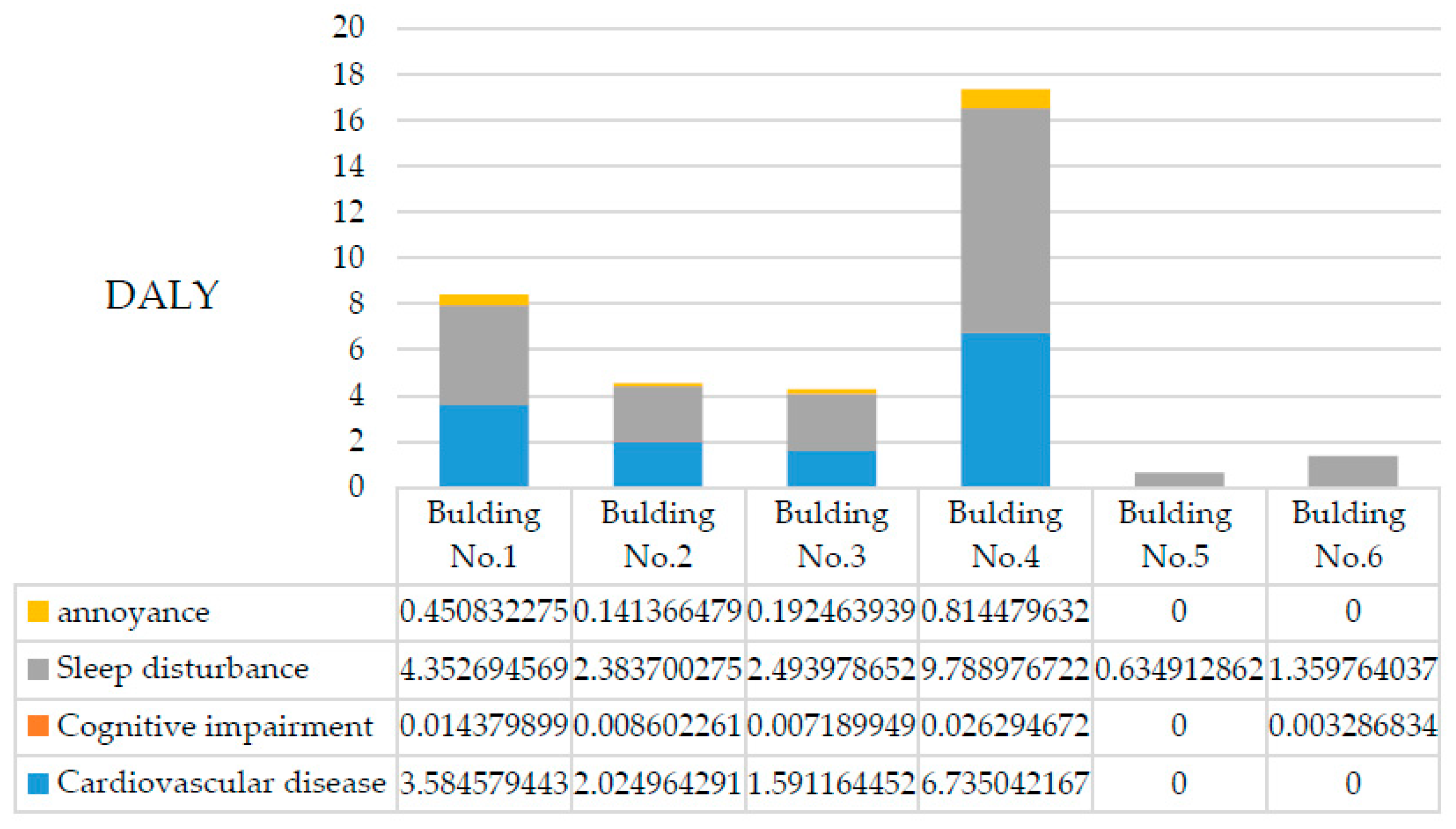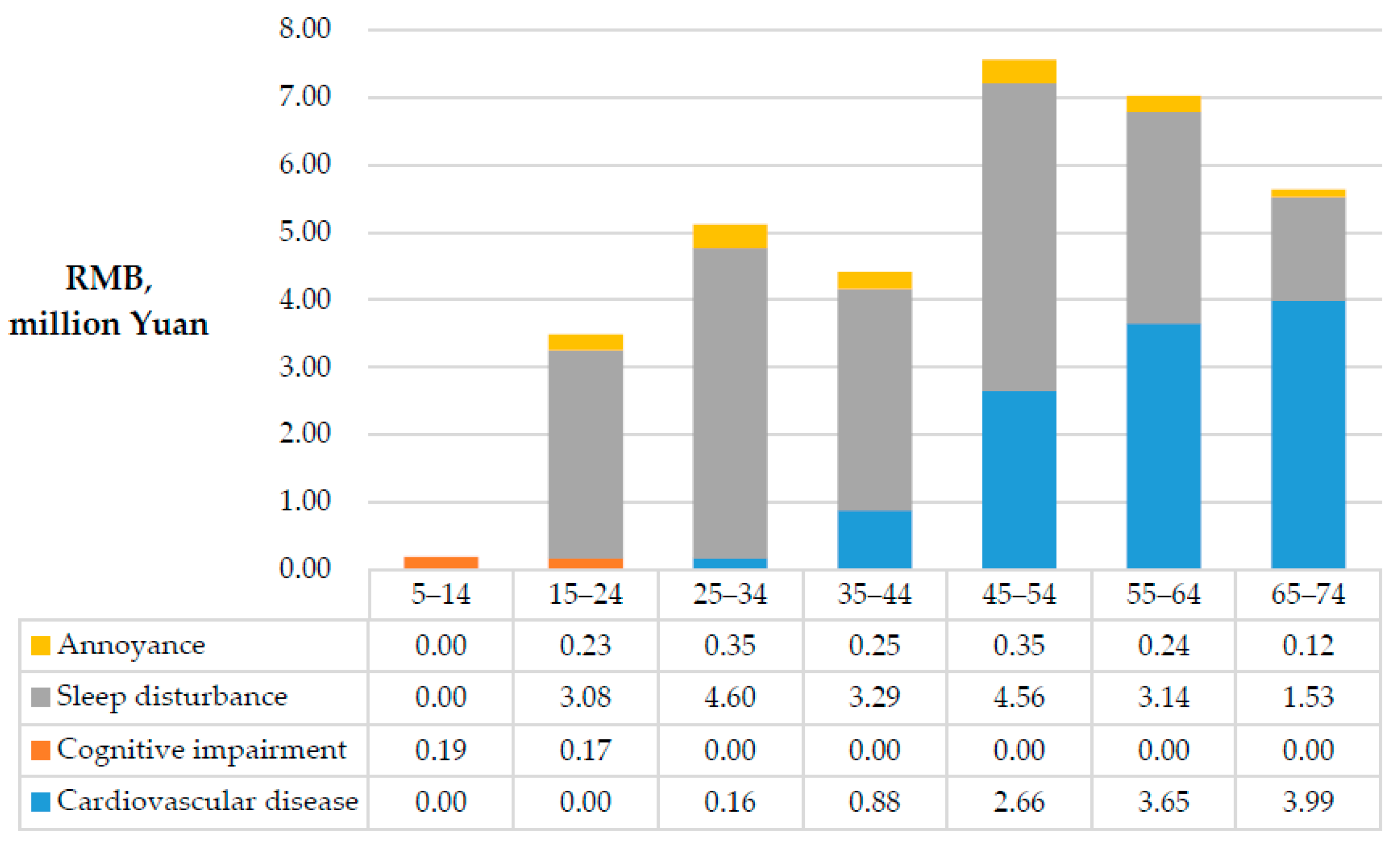1. Introduction
Noise pollution is a negative externality of construction activities, especially earthwork and concrete construction. People respond differently to noise pollution; however, when noise levels reach a certain threshold, people tend to be affected negatively [
1]. In China, 42.1% of environmental complaints are associated with acoustic pollution, 25.6% of which are attributed to construction noise, and acoustic pollution is becoming a more serious problem as rapid urbanization occurs [
2]. Given that the typical projected goals for population urbanization levels increase from 52.6% in 2012 to approximately 60% by 2020, vast construction projects underway to meet the needs of immigrants’ daily lives are creating pervasive environmental pollution and insufferable noise for the neighboring communities. In addition, the impacts of construction noise may be growing more serious because the increasing population density means that more individuals are becoming more exposed to construction noise. Thus, it is critical to take steps to balance the desire for urbanization with sustainable development.
Many measures have been taken to mitigate construction noise pollution. One common method is to reduce noise emissions at the source by using quiet construction technology and equipment and limiting the duration of noisy activities. When source control is unable to reduce noise levels at receptors to below critical levels, the next most common measure is to place obstacles, such as soundproof barriers and enclosures, along the transmission path [
3,
4]. In addition, some novel techniques derived from industry, such as active noise control techniques [
5] and off-site construction [
6], can be introduced as supplemental measures to overcome the limitations of the above-mentioned method. However, these above-mentioned measures have high investment costs. For noise control to be successfully implemented in practice, governments must not only implement a strict regulatory system but also develop economic, social and environmental criteria that make such investments worthwhile.
As economic leverage for motivating enterprises to take steps to consciously reduce their pollution, a noise pollution discharge and compensation fee rule has been enforced by the Chinese government in the first national law against noise pollution [
7]. In most cities, the discharge fee is intended to fund activities related to noise abatement. A contractor must pay the noise discharge fees to the environmental protection department if the environmental noise boundary of a construction site exceeds the standard limits [
8]. The amount of this fee depends on the degree of the violation, ranging from 350 yuan per month for 1 dB above the limit to 11,200 yuan per month for 16 dB or more above the limit [
9]. In Beijing, in addition to the discharge fee, a contractor who violates standard limits [
8] must compensate the neighboring community by household because of the noise nuisance [
10]. According to the rule [
10], the actual amount of compensation depends on a negotiation between the contractor and neighbors and is limited to 30–60 yuan per month. These current rules are easy to follow; however, they have three theoretical and operational drawbacks that make it difficult to provide persuasive judgments in their support. First, it is illogical to use the environmental noise level of a construction site boundary as a criterion to determine whether construction noise is a nuisance to neighboring communities, as the noise level at a receptor is not always consistent with that at a site boundary due to propagation attenuation [
8,
11]. Second, neither rule fully incorporates the health risks caused by noise pollution. Although the noise disturbance compensation rule [
10] admits that construction noise can disturb people’s lives, it does not expound upon the exposure–response relationship or even provide a disturbance-grading reference. It is arbitrary to weigh a noise nuisance based on an approximate noise level at a construction site boundary and negotiation. In addition, these rules were enacted many years ago. As environmental awareness and pollution-prevention costs are increasing, the negative externality of construction noise valued by those rules can neither offset people’s losses nor force enterprises to lower noise emissions. Thus, objective pollution assessment methods, as well as convenient estimation methods, are crucial for the economic leverage function of these rules.
Researchers worldwide have used two methods for studies of construction noise emission estimation: the first examines noise data from equipment [
3,
4,
12,
13,
14,
15] and the second from construction sites [
16]. Taking advantage of such estimation methods, individual exposure levels can be plausibly measured during the planning phase. However, most studies related to the environmental impacts of construction noise pollution still anchor estimates to noise exposure levels and to the number of communities affected [
16,
17,
18]. A few studies have targeted the negative externality of construction noise. In a study by Gilchrist [
19], three sources of social cost (productivity reduction, property damage, and health cost) associated with construction noise are outlined and valued by current bid evaluation methods. Nevertheless, the impacts of construction noise on these three sources were not presented in detail. Moreover, Hong et al. [
20] used official standards to calculate the environmental cost of construction noise, but the details of this standard are beyond the scope of this article. Thus, current estimates give no further reference regarding how pollution discharge and compensation fee rules for construction noise are developed and implemented.
Researchers have extended the environmental assessment of transportation noise pollution to social cost valuation using revealed [
21,
22,
23,
24,
25] and stated preference methods [
26,
27,
28,
29,
30]. The most common end points for valuation are typically expressed in the form of the Noise Depreciation Index (NDI) or the willingness to pay (WTP), which represent, respectively, the average decrease in house value caused by a 1-decibel increase in the noise level or the amount of money people are willing to pay (WTP) for a 1-decibel decrease in the noise level. These measurements can be directly applied to negotiate transportation-noise charge schemes. However, the models proposed by these studies are not suitable for the assessment of construction noise for two reasons. First, house prices are not vulnerable to construction noise because construction projects usually last 2 years or less. Additionally, the house prices of neighbors will go up if the building being constructed has a public service function. Second, it is questionable that people understand the associated health risks and will make corresponding choices when they value environmental goods [
31]. Hence, health risks are apparently more appropriate for deriving the social costs of construction noise.
It has long been recognized that noise has harmful impacts on health [
32]. Both experimental and epidemiological studies have been conducted over the years, and the results have revealed an increased disease incidence during periods of noise exposure [
33]. Disability-adjusted life years (DALYs) are one of the most widely used metrics for assessing the human burden of disease, and this measure has been adopted as an endpoint indicator for health risk assessment of noise [
34,
35,
36,
37,
38]. The concept of DALYs was developed in the original 1990 Global Burden of Disease (GBD) study to assess disease burden consistently across different diseases, risk factors and regions [
39], and the necessary parameters have been further updated by the World Health Organization (WHO) [
40]. A DALY measures the gap between the affected health status and ideal health status and equates it to the sum of time lived with disability and the time lost due to premature death. Social preference, for example, values the life year and can be incorporated to make the results more applicable for environmental decision making [
41]. As such, the DALY method is well suited for application in health risk assessment of construction noise.
This paper aims to establish a health risk assessment model for construction noise in Beijing based on the concept of DALYs. The model is intended to serve as a tool to assist the government in improving noise pollution-charge fee rules and to assist contractors in predicting health risks due to noise in order to optimize construction plans during pre-construction and to promote green construction. A commercial building in Beijing is used as a case study to demonstrate how the model works.
3. Application to Earthwork
This project is situated in the Da Shilan neighborhood, Xuan Wu District of Beijing, China. This project uses two work platforms, C1 and C2, and the earthwork construction is divided into five parts with a total workload of approximately 400,000 cubic meters. According to the project construction plan, the earthwork construction occurs 24 h a day, is executed by six excavators and eight dump trucks, and lasts 123 days. However, due to changes in site factors and the regulation limits of the Beijing city government, only two excavators are allowed to work, and the earthwork transportation is forbidden from 6:00 am to 11:00 pm, which extends the project schedule to at least 369 days.
Additionally, there are six adjacent buildings, including hotels and residential buildings, within 100 m. According to the “Environmental quality standard for noise” [
11], the level of environmental noise in the areas around this project should abide by the limits for the second area, which is 60 dB(A) during the daytime and 50 dB(A) at night.
3.1. Data Processing
In this case, the earthwork occurs from 11:00 pm to 6:00 am, and the excavators work all day. Because the environmental impact documents from this project have no relevant data regarding noise, its noise pollution data are collected by field measurement and simulation. The field measurements are performed from 11:00 pm to 6:00 am, and other noise sources that may impact the accuracy of monitoring are virtually nonexistent. The types of data collected include the sound levels of construction noise sources (SL
1), the local environmental noise levels around the site during construction (SL
2) and the indoor noise levels in the adjacent buildings (SL
3). For objectivity and convenience during analysis, data collection is conducted by field monitoring, following the guidelines of the “Emission standard of environmental noise for boundary of construction site” [
8], and analysis is performed using the noise-modeling software package SoundPLAN
TM Acoustics [
90]. Details of the collected data are summarized in
Table 4.
Based on the site conditions and the national standards [
8], noise observation points are set to collect noise data. Four of the noise observation points, which are labeled with numbers, are used to measure the noise level of the site, while the other points are set to collect mechanical noise data. The orientation of the observation points and the site terrain are shown in
Figure 2.
The residents living adjacent to the project refused indoor data monitoring; therefore, the environmental noise level before construction was set to 50 dB(A), as authorized by the local government [
11]. The environmental noise levels in the adjacent buildings during construction were simulated by SoundPLAN noise-modeling software based on the measured sound power level of the excavator (113 dB) and the environmental noise level before construction. The simulation results are shown in
Figure 3 and
Table 5. This study first simulates noise levels at the observation points and tests the validity of simulation by comparing the measured data and the simulation data. According to
Table 6, the correlation coefficient between the measured data and the simulation data is 1, which indicates a perfect correlation.
After noise data, population information (e.g., size, age and gender) is important for model application. Because the aim of this case study is not to investigate environmental impacts, but rather to present an application of the assessment model, the population-related data used were based on data collected by the local statistical bureau. According to the latest population census statistics of Beijing municipality [
91], the per capita floor space for people living in Xuan Wu is 23.54 square meters. Combined with the building area, the population size of each building can therefore be inferred. Then, the expected age and gender distributions for the population in each building can be deduced based on local data and the population size. The Beijing Statistical Association has published census information for the Xi Cheng district that accounts for 10 years and includes the sex ratio [
91]. In this case, the distributions of age and gender are assumed to be consistent with that of the Xi Cheng district. For the benefit of data integration, the age interval was set to 10 years, as shown in
Figure 4.
3.2. Assessment Results
Based on the above analysis of health risks and VSLY using the presented data on noise levels and population, the DALYs for each building were calculated and are presented in
Figure 5 and
Figure 6. In the process of DALY calculation, the disability duration of each health impairment, D, is consistent with the duration of the construction period because the evidence showed that these health impairments would disappear once the noise faded away [
33].
The total health risk for the neighboring community is 38.0 DALYs, and the corresponding expected social cost of construction noise in this case is almost 19.8 million yuan, of which Building No. 1, Building No. 3 and Building No. 4 are the main contributors. People living in these buildings faced significantly more health risk caused by construction noise for two reasons: (1) they are closer to the noise sources; and (2) there are no barriers to block the noise pathway. People living in Building No. 5 suffered the lowest DALYs because Building No. 4 obstructed the pathway between the noise sources and Building No. 5, where the residents were only slightly influenced by sleep disturbance.
5. Conclusions
During urbanization, numerous construction projects occur, which benefit city development and have an environmental impact on the surroundings. As a common source of environmental noise, construction noise not only deteriorates the acoustic climate quality but also threatens resident health, leading to many complaints. To prevent construction noise pollution, some municipal governments, such as that in Beijing, have decided to impose noise discharge fees, which incentivize contractors to reduce emissions. However, these rules are not adequate for policy purposes because thorough consideration of factors that are related to noise level, impact mechanisms and individual characteristics is lacking.
Accordingly, the present study proposes a health risk assessment model for construction noise and establishes an evaluation index for construction projects in Beijing, which has been adopted by the local government to revise noise discharge regulations. Impact assessment is performed using the DALY metric. Four well-accepted health impairments related to noise are thoroughly analyzed. Considering the mechanisms underlying the different health impairments, the related DALYs were assessed by noise level and based on other key factors, such as age, gender and local disease incidence. VSLY was invoked as a monetary index to quantify the social cost of construction noise. Based on the availability of data, the VSLY of individuals living in each district of Beijing are presented, which adds salience to the current noise discharge regulations. In addition, a case study of a construction project in downtown Beijing was used to demonstrate an application of the model.
The case study demonstrated the applicability of the proposed model for assessing the health risk of construction noise. Based on the construction plan, the health risks associated with construction noise from the earthwork case and the corresponding social cost were evaluated using the proposed model. The results of this case study indicate that the health risks caused by construction noise are limited to individuals living in buildings adjacent to construction sites; however, the social cost of the noise is serious. Using this model, administrative departments and contractors can directly predict the environmental impacts of construction noise and take the social cost of construction activity into consideration to implement environmentally friendly construction that helps avoid impairing the health of the people who live and work near a construction site.
However, additional work remains to be conducted. Measurement and assessment efforts based on the methods proposed in the present study should be applied to additional construction sites to gain sufficient empirical data to attain statistical significance. In addition, economic loss should be further investigated to objectively assess the social cost of construction noise. Note that, in principle, property damages evaluated by rental loss, occupancy loss and other kinds of income loss are determined by people’s perceptions of noise nuisance. Hence, simply combing the value of health risks and economic loss would lead to overestimation. Therefore, future improvements should also emphasize strategies and approaches using integrated methodologies.
